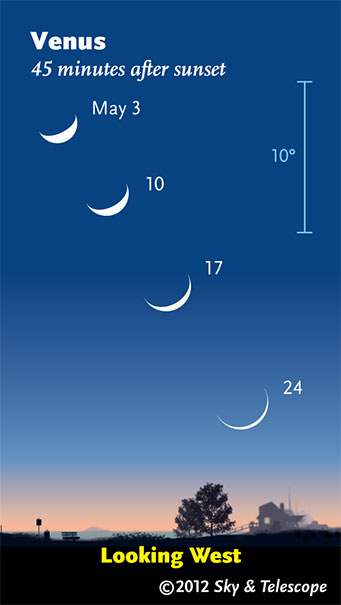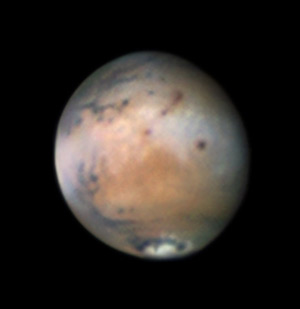
Seen in a telescope, Venus enlarges in diameter while waning in phase this month. It's coming nearer to Earth is it swings (in its faster orbit) toward the line between Earth and Sun. The 10° scale refers to Venus's height above the horizon, as seen from latitude 40° north, 45 minutes after sunset.
Sky & Telescope diagram
Friday, May 11
Saturday, May 12
Sunday, May 13
Monday, May 14
Tuesday, May 15
Two thirds of the way from Arcturus to Vega is the dim Keystone of Hercules.
Wednesday, May 16
Thursday, May 17
Friday, May 18
Saturday, May 19
Want to become a better amateur astronomer? Learn your way around the constellations. They're the key to locating everything fainter and deeper to hunt with binoculars or a telescope.
For an easy-to-use constellation guide covering the whole evening sky, use the big monthly map in the center of each issue of Sky & Telescope, the essential magazine of astronomy. Or download our free Getting Started in Astronomy booklet (which only has bimonthly maps).

The Pocket Sky Atlas plots 30,796 stars to magnitude 7.6 — which may sound like a lot, but that's less than one star in an entire telescopic field of view, on average. By comparison, Sky Atlas 2000.0 plots 81,312 stars to magnitude 8.5, typically one or two stars per telescopic field. Both atlases include many hundreds of deep-sky targets — galaxies, star clusters, and nebulae — to hunt among the stars.
Sky & Telescope
Once you get a telescope, to put it to good use you'll need a detailed, large-scale sky atlas (set of charts). The standards are the little Pocket Sky Atlas, which shows stars to magnitude 7.6; the larger and deeper Sky Atlas 2000.0 (stars to magnitude 8.5); and the even larger Uranometria 2000.0 (stars to magnitude 9.75). And read how to use sky charts effectively.
You'll also want a good deep-sky guidebook, such as Sue French's Deep-Sky Wonders collection (which includes its own charts), Sky Atlas 2000.0 Companion by Strong and Sinnott, the bigger Night Sky Observer's Guide by Kepple and Sanner, or the classic if dated Burnham's Celestial Handbook.
Can a computerized telescope replace charts? I don't think so — not for beginners, anyway, and especially not on mounts and tripods that are less than top-quality mechanically (able to point with better than 0.2° repeatability). As Terence Dickinson and Alan Dyer say in their invaluable Backyard Astronomer's Guide, "A full appreciation of the universe cannot come without developing the skills to find things in the sky and understanding how the sky works. This knowledge comes only by spending time under the stars with star maps in hand."
This Week's Planet Roundup
Mercury is hidden deep in the glow of sunrise.
Venus (magnitude –4.7 in Taurus) blazes as the "Evening Star" in the west-northwest in twilight. It's dropping lower every day now (see article, Venus Takes the Plunge).
Look high to Venus's upper right for Capella. Look just to Venus's right for Beta Tauri, also known as El Nath, glimmering only 1/300 as bright (at magnitude +1.6). They're slowly moving apart; Beta Tauri is 1.5° from Venus on May 11th and 2.0° from it by the 18th.
In a telescope, Venus is a crescent becoming more interesting all the time. It has enlarged to about 46 arcseconds tall while waning to about 15% sunlit; watch it changing daily. You may even see Venus's crescent shape with good, firmly braced binoculars.
Venus is plunging toward inferior conjunction, when it will transit the face of the Sun on June 5–6 (on the afternoon of the 5th for North America); see our article in the June Sky & Telescope, page 50, or online. This will be the last transit of Venus until 2117.

Although Mars was a mere 10.8 arcseconds wide on April 21st, Damian Peach recorded this extraordinarily fine image showing the brown heights of Olympus Mons (right of center) and the three other large Tharsis volcanos (above center) poking through a broad equatorial band of thin white clouds. South is up. In the North Polar Cap at bottom, note the dark Chasma Borealis extending inward from the cap's dark collar.
Damian Peach
Mars (magnitude +0.2) shines fire-orange under the belly of Leo. It's high in the south-southwest at dusk and lower in the southwest to west later in the evening. Spot Regulus 8° or 9° to Mars's right in twilight, and to its lower right later. They're moving farther apart daily. Fainter Gamma Leonis is 8° above Regulus. Mars in a telescope is gibbous and small, 9 arcseconds wide, fading and shrinking.
Jupiter is in conjunction behind the Sun.
Saturn (magnitude +0.4, in Virgo) shines in the southeast in twilight and highest in the south around 11 p.m. The star 5° to Saturn's lower right in the evening is Spica, slightly fainter and bluer.
Uranus (magnitude 5.9, at the Pisces-Cetus border) is very low in the dawn.
Neptune (magnitude 7.9, in Aquarius) is low in the east-southeast before dawn.
All descriptions that relate to your horizon — including the words up, down, right, and left — are written for the world's mid-northern latitudes. Descriptions that also depend on longitude (mainly Moon positions) are for North America. Eastern Daylight Time (EDT) equals Universal Time (also known as UT, UTC, or GMT) minus 4 hours.
Like This Week's Sky at a Glance? Watch our weekly SkyWeek TV short. It's also playing on PBS!
To be sure to get the current Sky at a Glance, bookmark this URL:
http://SkyandTelescope.com/observing/ataglance?1=1
If pictures fail to load, refresh the page. If they still fail to load, change the 1 at the end of the URL to any other character and try again.
 0
0
Comments
You must be logged in to post a comment.